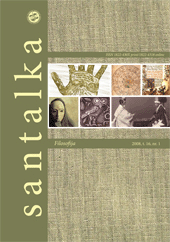Gandų klasifikavimo problema: kultūrinių gandų ypatumai
The Problem of Classification of Rumours: Peculliarities of Cultural Rumours
Author(s): Valdas PruskusSubject(s): Philosophy
Published by: Vilnius Gediminas Technical University
Keywords: rumour; social group; culture; cultural types of rumours; classification.
Summary/Abstract: The paper analyses classification of rumours. There were many attempts to classify rumours using different criteria. Some authors (A. Dmitrijev 1995) classify them in accordance with three main spheres of social life where they function: political, economic and ideological rumours. However, such a classification is rather conditional, thus it will always seem to be roughcast.Other authors (P. Sorokin 1991) classify rumours in accordance to social elements of interaction systems: the quality and quantity of communicating (interacting) individuals, type of interaction and character of information conveyors. This classification seems to be more sociological because it enables to identify which groups spread rumours and how they do it. However, this classification does not mention other important things: the content of a rumour, its relation to reality and so on. The American sociologists W. A. Peterson and N. P. Gist (1951) classify rumours into types according to their content (political, economic, etc.), time orientation (explaining past, predictive or foretelling), origin (spontaneous, purposive) or relation with reality (rational, fantastic). So there is not one classification of rumours. Partially it is conditioned by a multiple nature of rumours. On the other hand, it is important not only to classify rumours but also to have some mechanism which is able to reveal functioning peculiarities of a particular rumour. The author of this study supposes that every rumour despite its topics has certain features which can be set using a particular system of criteria. There are ten criteria which can describe a rumour and name the peculiarities of its functioning and spread. They help to define any rumour and include the social actualness of a rumour (actualandunreal), the purpose of a rumour (popular, unpopular), the nature of a rumour (malicious or entertaining (jokes), the depth of a rumour (superficialordeep), the supplier (author) of a rumour (known, authoritative or unknown), the receiver of a rumour (activist or amateur), the object of rumour contents (individuals, social groups, institutions), the area of rumour spread (country, region, village, social group, professional group), the duration of rumour existence (short-lived, long-lived), the restrictions of rumour spread (juridical and moral sanctions for spreading the rumour or absence of them). Despite the fact that rumours spread in different original spheres of human activities, their influence and possible social consequences can be different. According to the mentioned criteria, they can be not only evaluated, but also the peculiarities of their expression can be set. In accordance to the above-mentioned criteria, the study analyses the cultural types of rumours.
Journal: Santalka: Filologija, Edukologija
- Issue Year: 16/2008
- Issue No: 1
- Page Range: 70-78
- Page Count: 9
- Language: Lithuanian

